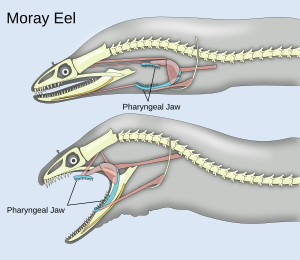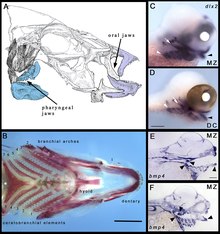(Q016) Based On Molar Form, To Which Animal Does This Jaw Belong?


Pharyngeal jaws are a "second set up" of jaws contained within an animate being's throat, or pharynx, distinct from the primary or oral jaws. They are believed to have originated equally modified gill arches, in much the aforementioned way as oral jaws. Originally hypothesized to take evolved but one time,[1] current morphological and genetic analyses suggest at to the lowest degree 2 separate points of origin.[2] [iii] Based on connections between musculoskeletal morphology and dentition, diet has been proposed as a main driver of the evolution of the pharyngeal jaw.[4] [5] A study conducted on cichlids showed that the pharyngeal jaws can undergo morphological changes in less than ii years in response to their diet.[half-dozen] Fish that ate hard-shelled casualty had a robust jaw with molar-like teeth fit for burdensome their durable prey. Fish that ate softer prey, on the other hand, exhibited a more than slender jaw with thin, curved teeth used for tearing apart fleshy prey.[5] These rapid changes are an case of phenotypic plasticity, wherein environmental factors affect genetic expression responsible for pharyngeal jaw development.[6] [vii] Studies of the genetic pathways advise that receptors in the jaw bone reply to the mechanical strain of biting hard-shelled prey, which prompts the formation of a more robust set of pharyngeal jaws.[7]
Cichlids [edit]
A notable example are fish from the family Cichlidae. Cichlid pharyngeal jaws have become very specialized in casualty processing and may accept helped cichlid fishes become ane of the near diverse families of vertebrates.[viii] However, later studies based on Lake Victoria cichlids suggest that this trait may also become a handicap when competing with other predator species.[nine]
Moray eels [edit]
Most fish species with pharyngeal teeth practise not take extendable pharyngeal jaws. A peculiarly notable exception is the highly mobile pharyngeal jaw of the moray eels. These are mayhap a response to their disability to eat every bit other fishes do past creating a negative pressure in the mouth, perhaps induced by their restricted environmental niche (burrows) or in the air in the intertidal zone.[ten] Instead, when the moray bites casualty, it showtime bites normally with its oral jaws, capturing the prey. Immediately thereafter, the pharyngeal jaws are brought frontwards and bite down on the prey to grip information technology; they and so retract, pulling the prey downwardly the moray eel'south gullet, assuasive it to be swallowed.[11]
Pop culture [edit]
The exceptional mobility of the moray eel'south pharyngeal jaws was discovered in 2007 by UC Davis scientists. Almost 30 years before (in 1979), the fictional xenomorph species from the Alien film series was get-go depicted showing a second set of jaws for attacking its prey. However, at that time pharyngeal jaws in other fishes were already known.[12]
The final dominate of Monster Hunter Rise Narwa, also as her male counterpart Ibushi possess pharyngeal jaws within their throats.
References [edit]
- ^ Harvard University.; University, Harvard (1981–1986). Breviora. Vol. no.464-487 (1981-1986). Cambridge, Mass.: Museum of Comparative Zoology, Harvard Academy.
- ^ Mabuchi, Kohji; Miya, Masaki; Azuma, Yoichiro; Nishida, Mutsumi (2007). "Independent development of the specialized pharyngeal jaw apparatus in cichlid and labrid fishes". BMC Evolutionary Biology. 7 (1): 10. doi:10.1186/1471-2148-seven-10. PMC1797158. PMID 17263894.
- ^ Wainwright, Peter C.; Smith, W. Leo; Price, Samantha A.; Tang, Kevin L.; Sparks, John Due south.; Ferry, Lara A.; Kuhn, Kristen L.; Eytan, Ron I.; Nearly, Thomas J. (2012). "The Evolution of Pharyngognathy: A Phylogenetic and Functional Appraisal of the Pharyngeal Jaw Key Innovation in Labroid Fishes and Across". Systematic Biological science. 61 (6): 1001–1027. doi:10.1093/sysbio/sys060. ISSN 1063-5157. JSTOR 41677996. PMID 22744773.
- ^ Grubich, Justin (2003). "Morphological convergence of pharyngeal jaw structure in durophagous perciform fish". Biological Journal of the Linnean Society. 80 (1): 147–165. doi:ten.1046/j.1095-8312.2003.00231.x. ISSN 1095-8312.
- ^ a b Aguilar-Medrano, Rosalía (Jan 2017). "Ecomorphology and evolution of the pharyngeal apparatus of benthic damselfishes (Pomacentridae, subfamily Stegastinae)". Marine Biology. 164 (1): 21. doi:10.1007/s00227-016-3051-three. ISSN 0025-3162. S2CID 90985865.
- ^ a b Gunter, Helen Grand.; Fan, Shaohua; Xiong, Fan; Franchini, Paolo; Fruciano, Carmelo; Meyer, Axel (2013-08-19). "Shaping development through mechanical strain: the transcriptional footing of nutrition-induced phenotypic plasticity in a cichlid fish". Molecular Environmental. 22 (17): 4516–4531. doi:x.1111/mec.12417. ISSN 0962-1083. PMID 23952004. S2CID 17490095.
- ^ a b Schneider, Ralf F.; Li, Yuanhao; Meyer, Axel; Gunter, Helen Grand. (2014-07-xxx). "Regulatory cistron networks that shape the development of adaptive phenotypic plasticity in a cichlid fish". Molecular Environmental. 23 (18): 4511–4526. doi:10.1111/mec.12851. ISSN 0962-1083. PMID 25041245. S2CID 8021527.
- ^ Hulsey, C.D.; Garcia de Leon, F.J.; Rodiles-Hernandez, R. (2006). "Micro- and macroevolutionary decoupling of cichlid jaws: A test of Liem's fundamental innovation hypothesis". Evolution. 60 (x): 2096–2109. doi:10.1111/j.0014-3820.2006.tb01847.x. PMID 17133866. S2CID 22638283.
- ^ McGee, Matthew D.; Borstein, Samuel R.; Neches, Russell Y.; Buescher, Heinz H.; Seehausen, Ole; Wainwright, Peter C. (27 Nov 2015). "A pharyngeal jaw evolutionary innovation facilitated extinction in Lake Victoria cichlids". Science. 350 (6264): 1077–1079. Bibcode:2015Sci...350.1077M. doi:x.1126/science.aab0800. ISSN 0036-8075. PMID 26612951.
- ^ Fox, Alex (23 June 2021). "To Capture Casualty on State, This Eel Has an Extendable, Actress Jaw Hidden Inside Its Pharynx". Smithsonian . Retrieved 28 June 2021.
- ^ Mehta, Rita S.; Wainwright, Peter C. (6 September 2007). "Raptorial jaws in the throat help moray eels swallow large prey". Nature. 449 (7158): 79–82. Bibcode:2007Natur.449...79M. doi:x.1038/nature06062. PMID 17805293. S2CID 4384411.
- ^ Zimmer, Carl (eleven September 2007). "If the First Bite Doesn't Do Information technology, the Second One Will". The New York Times. ISSN 0362-4331. Retrieved 3 July 2016.
External links [edit]
- "'Alien' Jaws Assist Moray Eels Feed". UC Davis. 2007-09-05.
- "Moray Eels Are Uniquely Equipped to Pack Big Prey Into Their Narrow Bodies". National Science Foundation. (article explaining moray eel pharyngeal jaws)
- "Video of a moray eel eating". Archived from the original on 2021-12-21.
Source: https://en.wikipedia.org/wiki/Pharyngeal_jaw
Posted by: clarksonoblipt58.blogspot.com

0 Response to "(Q016) Based On Molar Form, To Which Animal Does This Jaw Belong?"
Post a Comment